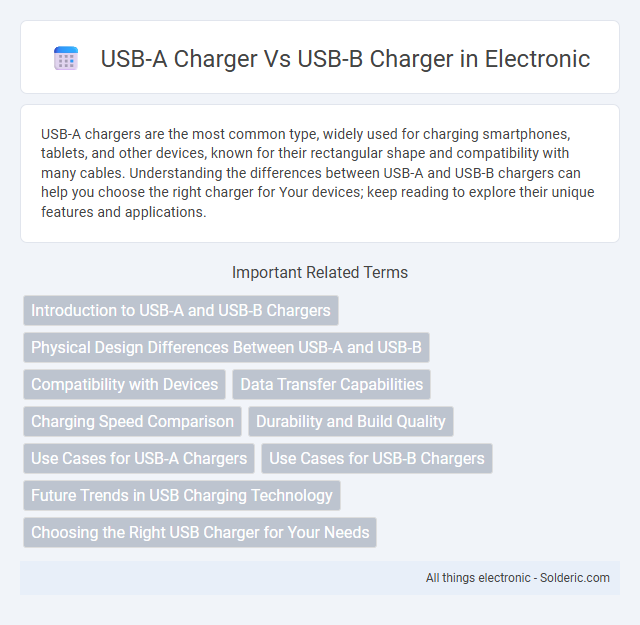USB-A chargers are the most common type, widely used for charging smartphones, tablets, and other devices, known for their rectangular shape and compatibility with many cables. Understanding the differences between USB-A and USB-B chargers can help you choose the right charger for Your devices; keep reading to explore their unique features and applications.
Comparison Table
| Feature | USB-A Charger | USB-B Charger |
|---|---|---|
| Connector Type | Flat, rectangular | Square-shaped with beveled edges |
| Common Use | Charging smartphones, tablets, general devices | Primarily printers, scanners, some external drives |
| Power Output | Up to 5V, 2.4A standard; USB-PD supports higher | Typically 5V, up to 1.5A |
| Data Transfer Speed | USB 2.0 (480 Mbps) to USB 3.2 Gen 2 (10 Gbps) | USB 2.0 (480 Mbps) |
| Reversibility | Not reversible | Not reversible |
| Compatibility | Widely compatible with modern devices | Limited, mostly legacy or specialized equipment |
| Physical Size | Smaller and slim | Larger and bulkier |
Introduction to USB-A and USB-B Chargers
USB-A chargers feature a rectangular connector widely used for charging smartphones, tablets, and other devices, offering broad compatibility with numerous USB cables and ports. USB-B chargers have a square-shaped connector commonly used with printers, scanners, and some external hard drives, designed to provide stable power delivery for peripheral equipment. Understanding your device's port type is essential to select the appropriate charger and ensure efficient and safe charging.
Physical Design Differences Between USB-A and USB-B
USB-A chargers feature a flat, rectangular connector designed for easy insertion into host devices such as computers or wall outlets, while USB-B chargers have a square-shaped connector with beveled exterior corners, primarily used for connecting to peripheral devices like printers. The distinct physical design ensures that USB-A connectors are generally user-friendly for repeated plugging and unplugging, whereas USB-B connectors offer a secure fit to maintain a stable connection. Understanding these physical design differences can help you choose the appropriate charger based on device compatibility and connection stability.
Compatibility with Devices
USB-A chargers feature a rectangular connector widely supported by smartphones, tablets, and peripherals, making them highly compatible with a vast range of devices. USB-B chargers, typically square-shaped, are primarily used for printers, scanners, and certain external hard drives, limiting their device compatibility. Choosing the right charger depends on your device's port type, as USB-A is versatile for everyday electronics, while USB-B targets specific accessory connections.
Data Transfer Capabilities
USB-A chargers primarily focus on power delivery with limited data transfer capabilities, typically supporting USB 2.0 speeds up to 480 Mbps. In contrast, USB-B chargers, often used for peripherals like printers and scanners, support higher data transfer rates depending on the USB version, reaching up to USB 3.0 speeds of 5 Gbps or more. The data transfer performance of USB-B chargers makes them more suitable for devices requiring rapid and stable data communication alongside charging.
Charging Speed Comparison
USB-A chargers typically deliver charging speeds up to 12W, supporting standards like USB 2.0 and USB 3.0 with current outputs around 1.5A to 3A, while USB-B chargers, used primarily for device connectivity rather than charging, generally do not offer higher charging speeds. USB-B ports are commonly found on printers and external hard drives, offering slower or no dedicated charging capabilities compared to USB-A's widespread use in power delivery. For faster charging, USB-C has become the preferred standard over both USB-A and USB-B due to its higher power delivery and data transfer rates.
Durability and Build Quality
USB-A chargers typically offer robust durability with widely standardized components designed for frequent plugging and unplugging, ensuring long-term reliability. USB-B chargers, often used for peripherals like printers and scanners, feature a sturdier connector build but may experience wear faster due to less frequent use and bulkier cable design. Overall, USB-A chargers provide enhanced build quality suited for daily heavy use, while USB-B chargers prioritize secure connections with moderate durability.
Use Cases for USB-A Chargers
USB-A chargers are widely used for powering and charging common electronic devices such as smartphones, tablets, wireless headphones, and portable speakers due to their compatibility with a broad range of USB cables and chargers. Their ubiquity in computer peripherals, including keyboards, mice, and external hard drives, makes USB-A ports essential for everyday computing needs. USB-A chargers also support fast charging protocols like Quick Charge, making them ideal for rapid energy replenishment in compatible gadgets.
Use Cases for USB-B Chargers
USB-B chargers are primarily used to power and connect peripheral devices such as printers, external hard drives, and scanners, providing reliable data transfer and charging capabilities. Their square-shaped connectors fit specific devices, making them ideal for office setups and specialized equipment requiring stable power sources. When choosing a charger, your decision should consider whether your device supports USB-B, ensuring compatibility and optimal performance.
Future Trends in USB Charging Technology
USB-A chargers, widely used for their compatibility and reliability, are increasingly being supplemented by USB-C technology, which offers faster data transfer and higher power delivery, aligning with future trends in USB charging. USB-B chargers, traditionally used for peripheral devices like printers, are less common in personal charging solutions but continue to evolve with improvements in power efficiency and secure connections. The industry is moving towards universal charging standards emphasizing USB Power Delivery (USB-PD), promoting cross-device compatibility and enhanced charging speeds across USB-A, USB-B, and USB-C formats.
Choosing the Right USB Charger for Your Needs
Choosing the right USB charger depends on the device compatibility and charging speed requirements, with USB-A chargers offering broad compatibility and widespread use for everyday electronics, while USB-B chargers are specialized for printers and certain industrial devices. USB-A chargers typically support charging speeds up to 12W, suitable for smartphones and tablets, whereas USB-B chargers, often used in conjunction with USB 2.0 or 3.0 ports, facilitate data transfer alongside moderate charging capabilities. Assessing the connector type and power output ensures optimal performance and device safety during charging.
USB-A charger vs USB-B charger Infographic

 solderic.com
solderic.com